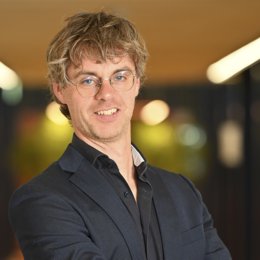In his inaugural lecture, Professor Massimo Sartori (UT, TechMed Centre) introduced the concept of the neuromuscular robotics revolution. Inspired by friends and family who lost mobility after a stroke and spinal cord injury, Sartori has dedicated his career to understanding how the human nervous system controls movement and translating that knowledge into wearable robotic technologies that can restore mobility.
Rather than focusing only on robotics, Sartori pioneered an approach centred on the human side of movement, building detailed digital models of the neuromuscular system and decoding the 'neural code' of movement directly from motor neurons. His team has developed techniques to non-invasively record neural signals, transform them into biomechanical models, and use these in real time to control exoskeletons, prosthetics, and bionic limbs.
His work has already shown that stroke survivors, people with spinal cord injuries, and amputees can regain control over movement using these neuro-muscular interfaces. These technologies are not only restoring basic motor functions but also enabling natural, fine-grained control of robotic limbs.
Looking ahead, Sartori aims to address a major unknown: how long-term use of wearable robots changes our body tissues. By combining robotics with tissue engineering, his lab is developing 'robo-reactors', robots designed to regenerate and strengthen muscles by applying targeted stimuli. This paradigm shift could transform rehabilitation from mere motor training to true biological repair and regeneration.
Impact message for society
The neuromuscular robotics revolution envisions a future where paralysis and disability no longer dictate quality of life. By merging neuroscience, biomechanics, robotics, and regenerative medicine, Sartori’s work is paving the way for wearable technologies that not only assist movement but also heal and protect the body over time. This has implications far beyond the clinic, enhancing independence, extending healthy ageing, and redefining what it means to live with injury or disability.
Q&A
What does it mean for a robot to 'understand' the human nervous system?
Robots, such as exoskeletons or bionic limbs, typically 'understand' movement in terms of forces or torques, whereas the human nervous system communicates through electrical signals. To bridge this gap, we developed a kind of translator. This neuro-muscular interface converts the bioelectrical signals produced by spinal motor neurons into leg biomechanical forces that a robot can interpret and act upon. This approach opens the door to a new generation of neurally interfaced wearable robots that not only support human movement but can also interact naturally with the neuromuscular system, ultimately improving health and rehabilitation outcomes.
How soon could patients expect to see these technologies in clinical practice?
In the field of bionic legs, we have already completed a first round of clinical tests with trans-tibial amputees in collaboration with Roessingh Revalidatie Centrum, Radboudumc and HealthTech Nexus (a cooperation between Radboudumc and the UT). Building on this, we are now preparing follow-up trials that will take the technology outside the laboratory. If successful, and with the involvement of our industrial partner OttoBock Health Care, we could see this technology reach patients within the next five years. For stroke patients and neurally interfaced robotic leg exoskeletons, we are only now beginning the first patient trials, again in collaboration with Roessingh Revalidatie Centrum. This path is longer: after proving feasibility, we need to refine the neural interface to make it more wearable and user-friendly. For this reason, we anticipate a timeline of around 7-10 years before clinical deployment becomes a reality.
What are the ethical and societal implications of machines that can both assist and regenerate the human body?
This question relates to our work on robotic bioreactors, developed under the ERC Project ROBOREACTOR. These intelligent systems aim to autonomously identify the optimal combination of electrical and mechanical stimuli needed to regenerate damaged muscle tissue. If successful, the implications are profound: wearable robots could one day predict the onset of injuries (such as tendon ruptures or muscle strains) or degenerative conditions (such as sarcopenia) before they occur. They could then deliver 'bio-protective therapies' tailored to preserve muscle health, extend independence in ageing, and reduce pressure on already overburdened healthcare systems. At the same time, this raises critical ethical questions. Sensitive biological data, such as predictions about tissue health or susceptibility to disease, must be safeguarded to protect patients’ privacy and to prevent misuse by insurers, employers, or other actors. Building ethical safeguards into these technologies will be as important as their scientific development.
How do collaborations between engineering, medicine, and industry make this revolution possible?
The neuromuscular robotics revolution depends on the integration of diverse expertise. Engineers provide the tools to model the human neuromuscular system and design wearable robots, clinicians bring the medical knowledge and patient access needed to validate and apply these technologies, and industry ensures that promising prototypes can be scaled, certified, and made widely available. At the University of Twente, this ecosystem already exists, and it is strong! We work closely with Roessingh Revalidatie Centrum, Radboudumc, and Sint Maartenskliniek on clinical translation, but also with industrial leaders such as OttoBock, TMSi, Artinis on product development. Moreover, with international collaborators, we work to develop open-source software platforms like CEINMS-RT and MyoSuite, which are already used worldwide. This convergence of disciplines ensures that discoveries in the lab can be rapidly transformed into real-world solutions that benefit patients and society.







